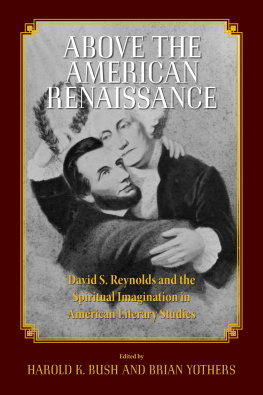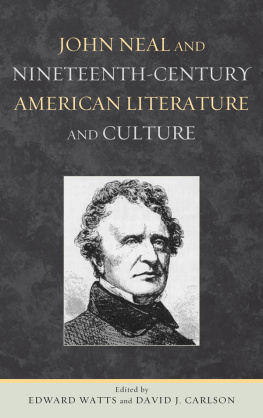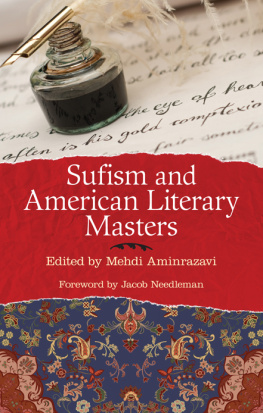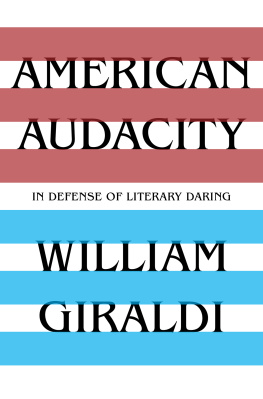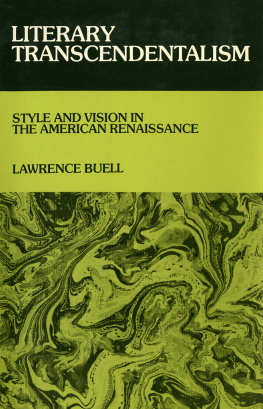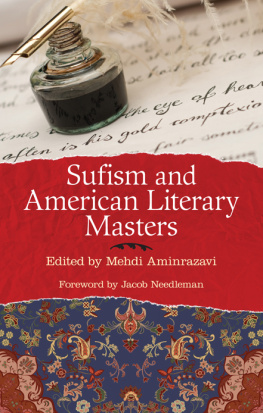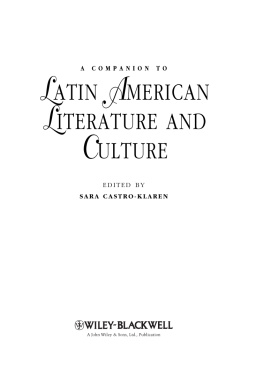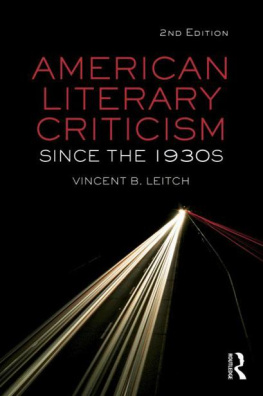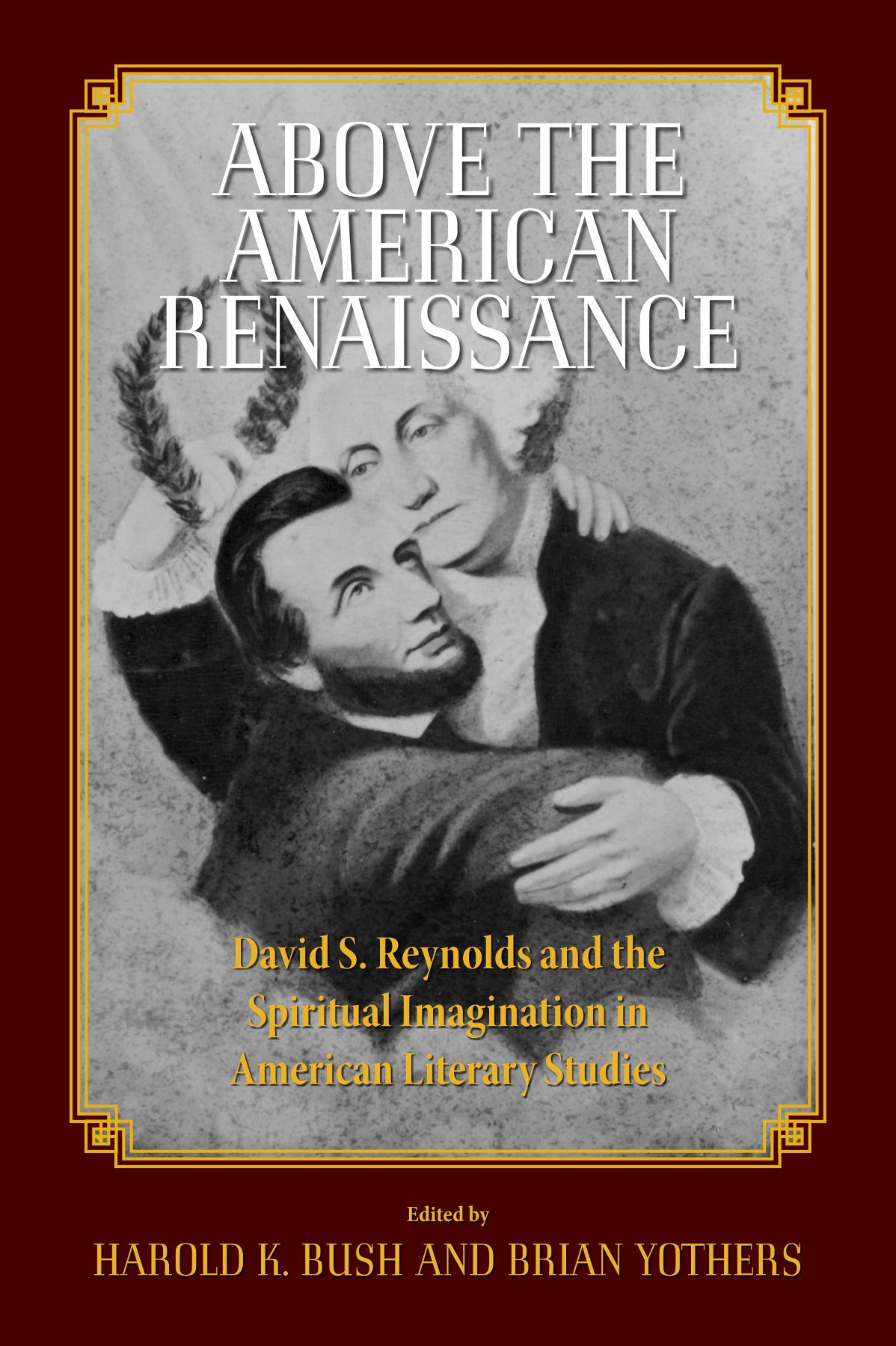
Above the American Renaissance
Above the American Renaissance
David S. Reynolds and the Spiritual Imagination in American Literary Studies
EDITED BY
Harold K. Bush and Brian Yothers
University of Massachusetts Press
AMHERST AND BOSTON
Copyright 2018 by University of Massachusetts Press
All rights reserved
ISBN 978-1-61376-601-9
Cover design by Sally Nichols
Cover art: S. J. Ferris., Washington & Lincoln (Apotheosis), c. 1865. Courtesy of Library of Congress.
Library of Congress Cataloging-in-Publication Data
Names: Bush, Harold K. (Harold Karl), 1956 editor. | Yothers, Brian, 1975
editor.
Title: Above the American renaissance : David S. Reynolds and the spiritual
imagination in American literary studies / edited by Harold K. Bush, Saint
Louis University, and Brian Yothers, University of Texas at El Paso.
Other titles: Spiritual imagination in American literary studies
Description: Amherst : University of Massachusetts Press, 2018. | Includes
bibliographical references and index. |
Identifiers: LCCN 2017050263 (print) | LCCN 2017055748 (ebook) | ISBN
9781613766002 (e-book) | ISBN 9781613766019 (e-book) | ISBN 9781625343598
(hardcover) | ISBN 9781625343604 (pbk.)
Subjects: LCSH: American literature-19th century-History and criticism. |
Spirituality in literature. | Religion in literature. | Religion and
literatureUnited StatesHistory19th century. | Reynolds, David S.,
1948 Beneath the American Renaissance.
Classification: LCC PS166 (ebook) | LCC PS166 .A26 2018 (print) | DDC
810.9/382dc23
LC record available at https://lccn.loc.gov/2017050263
British Library Cataloguing-in-Publication Data
A catalog record for this book is available from the British Library.
Contents
Tracking and Theorizing the Spiritual Turn in American Literary Studies
Reading the Spiritual Turn
Bronson Alcott, Transcendental Childhood, and the Search for Divinity
Religious Skepticism and the Literature of Misery
From Folk Magic to Freedom and Back Again
Moby-Dick and Nineteenth-Century Extinction Discourse
Uncle Toms Cabin and Biblical Higher Criticism
Print Technologies, Hermeneutics, and Castaway Readers
The American Bibles of Walt Whitman and Joseph Smith
An 1863 Novel by Ebenezer Wheelwright
From Jonathan Edwards to Charles Grandison Finney and the Second Great Awakening
Religious Verse and the Rise and the Fall of the Fireside Poets
Emily Dickinson and the Rise of Private Hymnody
Emily Dickinson, Thomas Wentworth Higginson, and Fascicle 14
Protestant Missions in Uncle Toms Cabin and Uncle Toms Cabin in Protestant Missions
Unholy Dying in The House of the Seven Gables
Abraham Lincoln and Religion
B RIAN Y OTHERS
Some scholarly books alter scholarly lives. My first encounter with David S. Reynoldss Beneath the American Renaissance was the stimulus for such an alteration. I first read the book in the spring before starting my doctoral studies in American literature, and his idea that the texts I was supposed to feel good about reading and the texts I felt duty-bound to scorn could be mutually illuminating in ways that shed equal light on cultural and aesthetic questions struck me with the force of revelation. Reynolds showed me that Edgar Allan Poes work could be newly viewed by the lurid light of George Lippards and George Thompsons sexually explicit male Subversive fiction; Herman Melvilles Moby-Dick could become freshly revelatory in the light of New England sermonic traditions; Ralph Waldo Emerson and Henry David Thoreau lived in the midst of the populist culture of their times rather than being dreamily abstracted from it. As I learned that reading sermons, pamphlets, popular fiction, and advice books was necessary to understanding one of American literatures most vibrant periods, I became increasingly certain that nineteenth-century American literature was a field I could study without fear of boredom or exhaustion.
Beneath the American Renaissance suggests that it is not only permissible but beneficial to scan the nineteenth-century literary archive with abandon. Indeed, it is practically mandatory in order to understand the most frequently assigned and discussed works of the period, both those that F. O. Matthiessen canonized decades ago in American Renaissance (Emerson, Melville, Thoreau, Nathaniel Hawthorne, and Walt Whitman) and those that have since been resurrected (Poe, Emily Dickinson, and, more recently, Harriet Beecher Stowe). For the young scholar looking to explore mid-nineteenth-century American literary culture more widely, the sky is the limit, and we owe much of this fervor and ferment to Reynoldss work in Beneath the American Renaissance.
The essays in this book, as our title Above the American Renaissance implies, take Beneath the American Renaissance as both a model and a provocation. In his introduction, Harold K. Bush notes that Reynoldss scholarship in the 1980s helped to reinvigorate investigations of religious culture; and since then, for reasons ranging from a rising respect for interdisciplinarity to the trauma of the 9/11 attacks and their aftermath, religion in literature has gone from a sideshow to a major area of inquiry for many nineteenth-century Americanists. The essays in our book seek to capture a moment in which questions related to religion and spirituality are being investigated with increasing urgency and skill. They both acknowledge the vibrancy of what is already happening in the intersection of literary and religious studies and point toward sustaining and extending those investigations.
Reynoldss Beneath the American Renaissance, first published in 1989, transformed Americanist literary studies by demonstrating the interconnections of popular and canonical literary cultures. Its topics range from race to poetics, and it considers both well-known authors such as Melville, Hawthorne, Dickinson, Whitman, and Stowe and more neglected figures such as Ebenezer Wheelwright, Augusta Jane Evans, Elizabeth Stoddard, and John Greenleaf Whittier. As the essays in our own book show, Reynoldss reconstructive methodology, which excavates previously unknown connections between popular and canonical literary cultures, meshes beautifully with the current emphasis among religious studies scholars on the lived experience of religion.
Our book is divided into three sections that highlight interlocking aspects of Reynoldss legacy. Part 1, which includes essays by Tracy Fessenden, John Matteson, Dawn Coleman, Zachary McLeod Hutchins, and Timothy Sweet, makes reference to Reynoldss reconstructive method of literary and cultural criticism as the contributors consider how to redraw the lines between the spiritual and the secular. Part 2, with essays by Gail K. Smith, Jeffrey Bilbro, Michael Robertson, Richard Kopley, and Mason I. Lowance, Jr., shows how scriptures are reconfigured in nineteenth-century American literature and culture. Part 3, including pieces by Claudia Stokes, Christopher N. Phillips, Vivian R. Pollak, Brian Yothers, and Jonathan A. Cook, illustrates the shifting boundaries of popular religious phenomena from hymns to missionary activity. Bushs introduction and David S. Reynoldss afterword demonstrate how these impulses interact in American literary scholarship and in the literary legacy of Abraham Lincoln.
We are grateful to Saint Louis University, the University of Texas at El Paso, the HSI-Pathways to the Professoriate Program, and the Frances Spatz Leighton Endowed Distinguished Professorship for their financial support of this project. David Goldfield, Judith Madera, Megan Marshall, and John Matteson answered many questions about the significance of cultural biography, and David S. Reynolds was unfailingly generous and supportive of our efforts. At the University of Massachusetts Press, Mary Dougherty has been an insightful and supportive editor at every step along the way. Finally, we thank our spouses, Hiroko Hara Bush and Maryse Jayasuriya, for their wisdom and encouragement.
Next page
